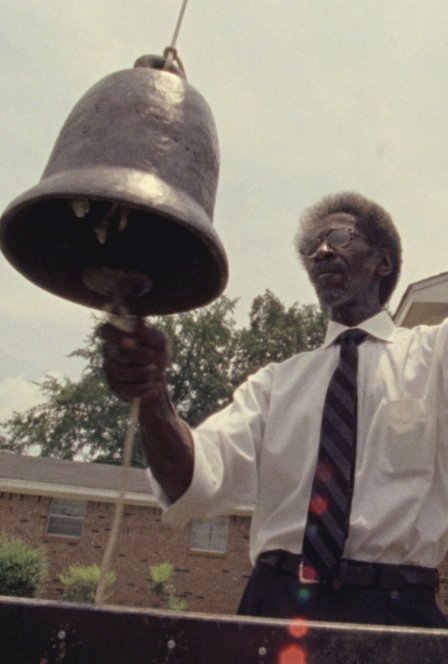Shot entirely in 16mm, The Island of St. Matthews takes place on a small island in the state of Mississippi. The director himself has personal connections to this community, and these ties are the inspiration behind the film. In an interview for Cineaste Kevin Jerome Everson said, “The Island of St. Matthews happened because I was looking for a lot of old photographs for artist’s books years ago. When I was down in Mississippi, I was asking my aunt on my mom’s side, ‘Where are the old pictures and stuff like that?’ And she kept saying, ‘We lost them in the flood.’”
Part experimental, part ethnographic, and part documentary film, The Island of St. Matthews is an extremely subjective work. Long naturalistic scenes depicting the scenery, such as a water skier circling the island or a nine-minute static shot of a dam barrage closing, are intertwined with brief snippets from interviews with local residents, many of whom seem to personally know the director. They usually talk about the 1973 flood. Frederick Wiseman meets James Benning.
In contrast to the vérité style of Frederick Wiseman, however, The Island of St. Matthews is devoid of any attempt at exploring the larger social implications behind the floods or the broader political conflicts and contradictions in the lives of the islanders. Currently, the island seems safer from devastating floods, but only recently has a dam been built to prevent further natural tragedies. Everson seems much more interested in filming the people of the island remembering stories of the flood and their quotidian water-filled environments.
I could easily visualize The Island of St. Matthews as a video-art piece part of a larger exhibition concerning the island, the artist’s personal story with the floods, the hardships of living in a poor black community in the middle of the water. I could be walking along the exhibition, looking at photographs, letters, physical items and utensils that speak of a particular history (and life story), and then suddenly sit down for some minutes to glimpse the film.
But while The Island of St. Matthews is certainly uneventful, that is not to say it is an uninteresting film — even if I find it hard to appeal to many spectators outside of academic circles or to those really interested in formal discussions on documentary cinema. In the aforementioned interview, Everson recounts how a bell that is constantly rung throughout the film was brought into town by the director himself, and how the vast majority of the scenes are either reenactments or rigorously and formally controlled moments. In this sense, I could easily find myself showing this film to a group of students and reflecting on a documentary tradition of blurring the personal, the naturalistic, and the reenacted — a practice whose modern form dates back to at least Michelle Citron’s Daughter Rite or Mitchell Block’s No Lies. We could watch these three films and read André Bazin’s The Ontology of the Photographic Image for the 456th time. However, that sounds like a rather dull way to spend an afternoon.
I’d much rather relate Everson’s film to my recent personal experience. Coincidentally, I just got back from a trip to an island some 200 km from where I live. The owner of the inn where I was lodged told me that he’s been living there for over 40 years (and that he had started fishing on his own at sea since he was 14). Only in recent years has tourism become a part of the community income. He told me a story regarding the first inn built there: not much longer after the owner had finished building the first four guest bedrooms, a tempestuous thunderstorm hit the island, completely destroying his modest building and hurling one of the bedrooms up on a treetop. During my trip, I could safely experience a controlled environment of being subjected to the whims of nature, as I had to rely on moonlight and flashlights during the evening and depend on the change of tides to move from the island to the mainland, but it was hard to imagine living in such a harsh environment four decades ago.
Maybe Everson felt too overwhelmed with his personal experience with the island, memory, nature, and water to believe he should construct a narrative from his naturalistic images. And much like the island in Everson’s film, water and nature are depicted as sources of both life and death, baptisms and floods. It’s not a particularly subtle, complex, or unique metaphor, and I won’t go on about further comparisons to my experience. I’d much rather just show you an image from my trip.

